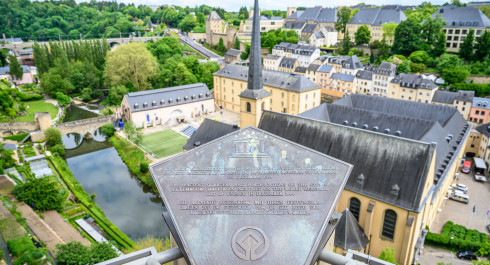
UNESCO in Luxembourg City
“There is so much greatness and grace here, so much gravity combined with gentleness, that one wishes Poussin had employed his wonderful talent in such an environment.” Goethe
UNESCO World Heritage

Thick bastions and bulwarks, battlement gates, parapets on steep sandstone rocks, fearsome embrasures – the mighty structures of the former Luxembourg fortress, once praised and feared as the “Gibraltar of the North”, were so impressive that Goethe, while on a short visit to the city in 1792, was inspired to write the following words: “He who has not seen Luxembourg simply cannot picture these war structures, juxtaposed and superimposed as they are (...). ”The famous writer expressed his greatest awe of the city of Luxembourg, however, in the following comment:“There is so much greatness and grace here, so much gravity combined with gentleness, that one wishes Poussin had employed his wonderful talent in such an environment.”
Other artists were no less overwhelmed by the magnificent phenomenon of the fortress. The English landscape painter William Turner captured the bold defence structures in expressive watercolours, while national writer Batty Weber described the “Corniche”, which runs along an imposing defence wall, as “Europe’s most beautiful balcony.”
The original modest defence structures were built as early as 963, when Siegfried, Count of the Ardennes, erected a castle on the Bock promontory, thus laying the foundation stone for the birth of the entire country. The fortress was continually extended by the foreign powers that ruled Luxembourg over the subsequent centuries. One after the other, Burgundian, Spanish, French, Austrian and Prussian rulers competed for the most well-fortified walls.
Sébastien Le Prestre de Vauban, fortress builder under Louis XIV, was one of the notable engineers who turned Luxembourg into a fortress structure that strategically became one of the most important in the whole of Europe. The most striking constructions include the underground casemates, which date back to the period of Spanish and Austrian foreign rules. The labyrinthlike defence passages and provision galleries are today one of the most popular sights of the city.
Despite the fact that from 1867 to 1883 many defence walls were dismantled, the remaining fortress works bear spectacular witness to the turbulent history of the capital of the Grand Duchy. In 1994, the powerful bulwarks and the old town, equally steeped in history, were listed as a UNESCO World Heritage Site.
Visit the underground fortifications of the former Gibraltar of the North, especially the Bock and Petrusse casemates!
Stroll along the "Chemin de la Corniche" and enjoy the panorama!
Discover the fortress walls by following the traces of Wenzel!
Immerse yourself in Luxembourg's heritage!
Guided city tours
UNESCO tours
Download the brochures and discover Luxembourg City on a UNESCO tour!
The document "UNESCO Tour Leichte Sprache" was produced in cooperation with the "Centre pour le développement des compétences relatives à la vue".
Photo gallery
Upcoming events in Luxembourg City
Are you visiting? Don't miss the next events:






















